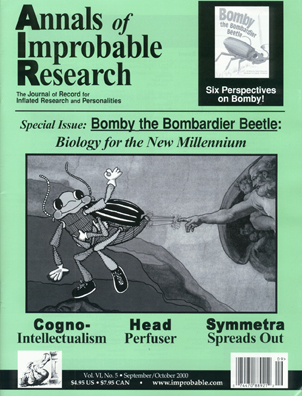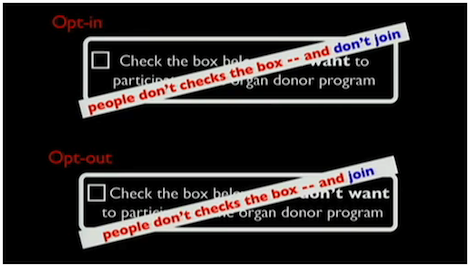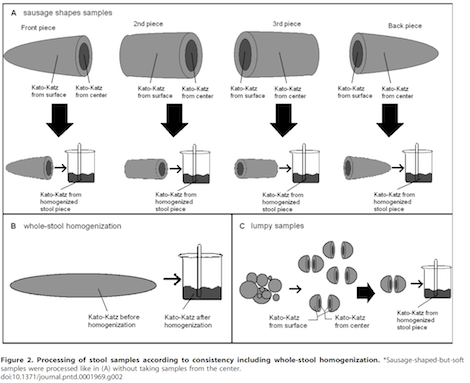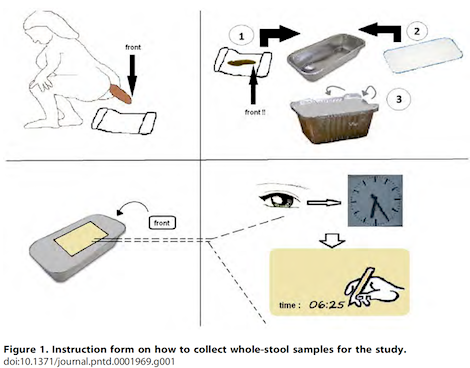Marc Abrahams's Blog, page 525
December 30, 2012
Perspectives on Bomby the Bombardier Beetle
The Sept/Oct 2000 issue of the Annals of Improbable Research featured seven perspectives on the curious creationist book Bomby the Bombardier Beetle, which is based screw-loosedly on the curious, real insect called the bombardier beetle:
Bomby, Bomby, Bomby (an introduction)* — Sally Shelton
Bomby: Thoughts of a Forensic Entomologist* — Mark Benecke
Creative Science Serves Up a Lukewarm Potboiler* — Harold P. Dowd
Bomby: The Military Review* — Earle Spamer
Carabid Family Values* — Brett C. Ratcliffe
Referee Report for “Bomby”* — Eric Schulman
Class Insecta is Dead* — Sally Shelton
Harry and Bomby* — Sally Shelton

December 28, 2012
Dan Ariely asks: Are we in control of our own decisions?
In this video, Ig Nobel Prize winner (for demonstrating that high-priced fake medicine is more effective than low-priced fake medicine) Dan Ariely asks: Are we in control of our own decisions?

Updated list of new patents for golfballs (Dec. 2012)

The number of new US golfball patents fell back to disappointingly average levels this December – down almost 28% on November’s figures.
• Golf balls having at least two core layers formed from HNP compositions
• High performance golf ball having a reduced-distance
• Multi-piece golf ball comprising low hardness gradient core
• Very-low melt flow thermoplastic composition for golf ball core layers
• Golf balls with clusters of dimples having non-uniform dimple profiles
ALERT: DON’T MISS! Coming soon, before the year ends! A partial Improbable analysis of the entire year’s golfball patents. In which figures are presented – graphs are plotted – and questions are asked.

Non-Math Academics Tend to Be Impressed by Equations
What’s the value of an equation? This study appears to show that, to academics who don’t use much mathematics, any equation can be impressive — no matter what the equation says, and whether or not it adds any clarity or knowledge to a situation:
“The Nonsense Math Effect,” Kimmo Eriksson, Judgement and Decision-Making, Vol. 7, No. 6, November 2012, pp. 746–749. (Thanks to investigator Mark Dionne for bringing this to our attention.) The author, at Mälardalen University in Västerås, Sweden, explains:
“Although potentially applicable in every discipline, the amount of training in mathematics that students typically receive varies greatly between different disciplines. In those disciplines where most researchers do not master mathematics, the use of mathematics may be held in too much awe. To demonstrate this I conducted an online experiment with 200 participants, all of which had experience of reading research reports and a postgraduate degree (in any subject). Participants were presented with the abstracts from two published papers (one in evolutionary anthropology and one in sociology). Based on these abstracts, participants were asked to judge the quality of the research. Either one or the other of the two abstracts was manipulated through the inclusion of an extra sentence taken from a completely unrelated paper and presenting an equation that made no sense in the context. The abstract that included the meaningless mathematics tended to be judged of higher quality. However, this ‘nonsense math effect’ was not found among participants with degrees in mathematics, science, technology or medicine.”
Here is some detail from the study:
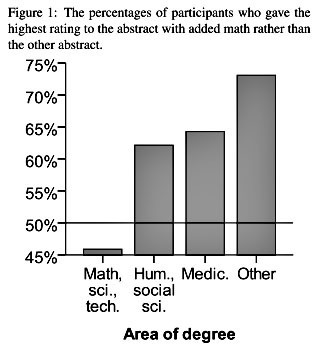
BONUS: An essay about this, by Kevin Drum.
BONUS: Professor Eriksson mentions, on his web site, a soon-to-be-published paper on a very different topic that seems likely to draw some attention:
Kimmo Eriksson (in press). Autism-spectrum traits predict humour styles in the general population. To appear in Humor: International Journal of Humor Research.

Economics experiments involving death and taxes
An essay by John Carney on MSNBS’s NetNet blog looks at several experiments involving the relationship between death and taxes. The newest experiment, like several of the old ones, is being conducted in the United States.
The essay does not fail to mention the study that earned the 2001 Ig Nobel Prize in economics (but does fail to mention the Ig Nobel Prize):
“Economists Wojciech Kopczuk of Columbia University and Joel Slemrod of the University of Michigan studied how mortality rates in the United States were changed by falling estate taxes. They note that while the evidence of “death elasticity” is “not overwhelming,” every $10,000 in available tax savings increases the chance of dying in the low-tax period by 1.6 percent. This is true both when taxes are falling, so that people are surviving longer to achieve the tax savings, and when they are rising, so that people are dying earlier, according to Kopczuk and Slemrod.”

December 27, 2012
Towards a radioactive urine substitute
“14C is one of the radionuclides for which the Canadian Nuclear Safety Commission has developed performance testing programmes (PTPs). During the PTP exercises, clients receive samples of natural urine containing spiked radionuclides, for testing. In these programmes, urine has disadvantages.
These include (1) slow collection times from donors, (2) unpleasant smell and (3) potential to transmit diseases.”
Prompting Joseph N Daka and colleagues at the Canadian National Calibration Reference Centre for Bioassay and In Vivo Monitoring, National Internal Radiation Assessment, Radiation Protection Bureau, Health Canada, Ottawa, ON, Canada, to come up with a solution. In the form of a significantly less unpleasant substitute – tea. In “Preparation and application of steeps of tea as new simulations of urine for the performance testing programme of 14C,” they write:
“The results of tea solutions compared well with those of urine. It was concluded that tea steeps, of which the spectroscopic and colour quenching properties have been adjusted, do provide appropriate urine simulations, suitable for use in PTPs.”
Sample publications explaining the technique:
Radiation Protection Dosimetry (2012) 151 (3): 420-425.
Health Physics: September 2012 – Volume 103 – Issue 3 – p 275–278
and
Radiation Protection Dosimetry (2012) 148 (2): 242-248.

“The Gold Bug” [fictional], and the real bug that accumulates gold
In 1843, Edgar Allen Poe wrote a fictional story called “The Gold Bug,” about a bug made of gold.
In 2012, Aaron Stewart, Ravi Anand and Jens Balkau wrote a scientific treatise about termites that accumulate gold in their nest:
“Source of anomalous gold concentrations in termite nests, Moolart Well, Western Australia: implications for exploration,” Aaron D. Stewart, Ravi R. Anand and Jens Balkau, Geochemistry: Exploration, Environment, Analysis, November 2012 v. 12 no. 4 p. 327-337. (Thanks to investigator Leah Blaine for bringing this to our attention.) The authors, at CSIRO Earth Science and Resource Engineering in Kensington, Western Australia, and at Regis Resources LTD, in Subiaco, Western Australia, report:
“The Moolart Well gold deposit lies in the Duketon Greenstone Belt in the Western Australian Goldfields in an area that has seen nearly 150 years of Au exploration with limited success due to the transported cover masking deposits. Here, the site displays no anomaly indicative of underlying mineralization within surface soils…. A series of samples from termite nests and surrounding soil were sampled along a transect from background areas to over mineralization…. Very high concentrations [of gold] (>5000 ppb) were found in >2000 µm fractions in nests over mineralization as a result of vertical transport of anomalous pisolitic gravels by termites. These results suggest termite-driven local soil heterogeneity and termite mounds being a consistent geochemical and mineralogical sample medium for the discovery of ore deposits beneath weathered cover and shallow sediments.”
BONUS: An earlier version of the termite paper
BONUS: ”Detection and dispersal of explosives by ants.” John E. McFee, Steve Achal, Anthony A. Faust, Eldon Puckrin, Andrew House, Damon Reynolds, William McDougall, and Adam Asquini, In Proc. SPIE, vol. 7303, pp. 730302-730310. 2009. (Thanks to @4tis for bringing this to our attention.)

December 26, 2012
Parasites in Pollen from the Pits of the Piazza of Parma
If you admire alliteration, we give you Rossela Rinaldi (et al.)’s Parasites in Pollen from the Pits of the Piazza of Parma:
“The Significance of Intestinal Parasite Remains in Pollen Samples from Medieval Pits in the Piazza Garibaldi of Parma, Emilia Romagna, Northern Italy,” Assunta Florenzano, Anna Maria Mercuri, Aurora Pederzoli, Paola Torri, Giovanna Bosi, Linda Olmi, Rossella Rinaldi and Marta Bandini Mazzanti, Geoarchaeology, vol. 27, no. 1, 2012, pp. 34–47.
Behold, please, this flawed video of the Piazza Garibaldi of Parma:
(Thanks to investigator Tom Gill for bringing this to our attention.)

Dr. Skeptic’s 1-2-3…to-100% factoids about medicine
The Dr. Skeptic blog lists 100 factoids about medicine, each drawn from medical reports — one factoid for each percentage in the range 1% to 100%, with a link to the source of that factoid. Here, below, are some items plucked from the entire list:
1% of population account for 1/5 of healthcare spending.
2% prevalence of Chronic Fatigue Syndrome in primary care – and up to 25% incidence of “prolonged fatigue”.
3% of boys in New Jersey have ‘Autism-spectrum disorder’.
4% of adults have PLMD (Periodic Limb Movement Disorder – a bit like RLS: Restless Legs Syndrome).
5% of adults have Restless Legs Syndrome.
6% of patients in a primary care setting have a social anxiety disorder.
7% of patients in a primary care setting have a panic disorder.
8% of patients in a primary care setting have a general anxiety disorder.
…
34% of middle-aged Dutch have ‘forgetfulness’, which apparently has 342 causes, 35 types and 501 symptoms.
35% of Americans are obese.
36% of referrals for cardiac stents from patients with heart attacks were found to be ‘false positives’, subjecting them to increased risks. The medicalization of heart disease is total, and the intervention rate is too high.
37% of men in the world have raised cholesterol (only another 14% and it would be normal).
38% of US doctors have ‘burnout’.
…
96% of breast cancer patients considering chemotherapy rate “living as long as possible” as their No 1 priority, according to doctors. According the patients themselves, it is only 53%. This explains why chemo is universally recommended by doctors, as quality of life is not adequately taken into consideration.
97% of people with celiac disease don’t even know they have it (so does that make it a problem or not?)
98% of children treated with medication for ADHD are initially given Ritalin, a drug that is also used as substitute therapy for cocaine addiction, is dependency forming and is associated with numerous side effects including cardiac arrest, psychosis and suicidal ideation.
99% of children screened at a New York school either previously had a tonsillectomy, or were assessed as needing one.
100% is the current world death rate, and it is holding steady.

The Remains of the Day or So: What’s in a Stool
A new study looks into a stool sample, to see whether the whole is indicative of the parts. The study’s title perhaps marks the start of a new era for medical journals. It uses plain, clear words:
“An In-Depth Analysis of a Piece of Shit: Distribution of Schistosoma mansoni and Hookworm Eggs in Human Stool,” Stefanie J. Krauth, Jean T. Coulibaly, Stefanie Knopp, Mahamadou Traoré, Eliézer K. N’Goran, Jürg Utzinger, PLoS Neglected Tropical Diseases, 6(12): e1969. The authors are at the Swiss Tropical and Public Health Institute, Basel, Switzerland, the University of Basel, Switzerland, Centre Suisse de Recherches Scientifiques en Cote d’Ivoire, and the Universite de Cocody, Abidjan, Cote d’Ivoire. They explain:
“An accurate diagnosis of helminth infection is important to improve patient management. However, there is considerable intra- and inter-specimen variation of helminth egg counts in human feces. Homogenization of stool samples has been suggested to improve diagnostic accuracy, but there are no detailed investigations. Rapid disintegration of hookworm eggs constitutes another problem in epidemiological surveys. We studied the spatial distribution of Schistosoma mansoni and hookworm eggs in stool samples, the effect of homogenization, and determined egg counts over time in stool samples stored under different conditions….
“Principal Findings: We found no clear spatial pattern of S. mansoni and hookworm eggs in fecal samples.”
Here are two diagrams from the study:
(Thanks to investigator Luciano Lemos-Filho for bringing this to our attention.)
BONUS (not really related): A study with a typo in its title (HT Deborah Blum and Stuart Cantrill)

Marc Abrahams's Blog
- Marc Abrahams's profile
- 14 followers


